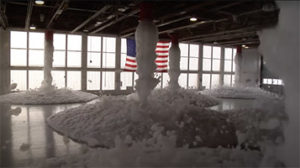Firefighters, airport workers, and military personnel across the country are currently filing AFFF lawsuits against major chemical manufacturers for exposure to Aqueous Film-Forming Foam. AFFF is a fire-suppression agent that contains chemicals called per- and polyfluoroalkyl substances (PFAS), which are classified as probable human carcinogens. Exposure to this group of chemicals has been strongly linked to a higher risk of cancer. Despite the fact that this is known, AFFF still poses an active risk—both through workplace exposure and the environment.
AFFF Firefighting Foam Development
AFFF has been in use for fire suppression since the 1960s. First developed by the United States Navy’s Naval Research Laboratory, it was innovative in its low viscosity and ability to spread rapidly when applied to liquid fuel—factors that dramatically improved efforts to fight aircraft and motor vehicle crash fires. The Navy developed this foam while conducting research alongside the Minnesota Mining and Manufacturing Company, the company known today as 3M. This research proved that the use of synthetic chemicals Perfluorooctanoic acid (PFOA) and Perfluorooctanesulfonic acid (PFOS), both members of the PFAS chemical family, would more effectively suppress fuel-based fires. Further, the foam’s functionality prevents re-ignition—once spread across petroleum-based liquid, it forms a film on the liquid’s surface that deprives it of oxygen, which provides near-instant fire suppression. By the end of the decade, all Navy vessels were carrying and using AFFF.
AFFF Use in the U.S. Military
Beginning in the 1970s, the Department of Defense employed the use of AFFF for suppression of fuel fires at all military bases and installations. Soon after, it was being used at airports and civilian fire departments throughout the country. To this day, the U.S. military is the largest user of firefighting foams, comprising an estimated 75% of the market, with the remainder consisting of municipal fire departments and petroleum-processing plants and refineries. From the 1970s through the mid-2010s, the military, airports, fire-departments, and the oil and gas industry were using AFFF on a frequent basis.
In usage, AFFF has been employed heavily in both active fire events and in procedural training. Those most heavily exposed include members of the U.S. Air Force, who used and trained with AFFF to fight aircraft fires. Those who served the U.S. Navy also report high exposure from using and training with AFFF for firefighting aboard military ships. Military and civilian firefighters alike report exposures ranging from inhalation while cleaning and reloading storage tanks, to riding aboard vehicles and vessels in close proximity to large quantities of foam, to contact with skin due to minimal protective gear. Some firefighters have reported using the foam to clean their protective outerwear, or even bathing in it after training or fire-suppression events.
Known Toxins and Health Risks Associated with AFFF
Despite the proven fact that both chemical manufacturers and the U.S. military have had knowledge of the toxicity of AFFF for decades, neither military nor civilian firefighters were directly alerted of these risks. Further, they weren’t provided with adequate personal protective equipment. The Department of Defense had begun investigating the harmful health and environmental effects of AFFF as far back as the early 1980s. Even still, it wasn’t until 2016 that the department halted land-based use of AFFF in training, testing, and maintenance, while also issuing directives ordering proper removal and disposal procedures of PFOS-based AFFF. While these new policies will mitigate the potential for future damage, the previous decades of unsafe usage has created a lasting public health and environmental crisis.
Although AFFF containing PFAS chemicals is no longer in use, it’s still posing a great risk to the environment. This is due to the massive amount of leftover AFFF that was stockpiled by the military and fire departments. As of 2019, over 3 million gallons of unused AFFF and related waste had been retrieved from U.S. military installations worldwide. To permanently dispose of the foam, the military had chosen the method of incineration—despite the fact that there had been little research on the safety of burning PFAS chemicals and significant evidence that this burning could potentially create byproducts just as dangerous as the foam itself. In some instances, incineration was taking place in residential areas, further exposing communities already impacted by the presence of the chemicals to more toxins. In some instances, incineration is being conducted in low-income areas. In a recent news release, associate director of the Center for the Advancement of Public Action at Bennington College David Bond states “In defiance of common sense and environmental expertise, the Department of Defense (DOD) has enlisted poor communities across the U.S. as unwilling test subjects in its toxic experiment with burning AFFF.” According to researchers, the DOD has rushed to destroy these products by any means necessary out of fear that new chemical classifications of AFFF would create new liabilities.
While research on the health risks associated with AFFF exposure is ongoing, epidemiological and animal studies strongly suggest links between exposure and serious illnesses. The EPA has classified PFAS as a probable human carcinogen, likely cancer-causing. Those who are currently filing claims are suffering from a wide variety of illnesses, the most common being kidney cancer, testicular cancer, pancreatic cancer, bladder cancer, leukemia, lymphoma, neuroendocrine tumors and prostate cancer. At Wilentz, practiced attorneys experienced in similar litigation are fighting for fair compensation for those suffering due to the negligence of AFFF manufacturers. If you are suffering from a serious illness after exposure to AFFF, call our offices for a free consultation to assess your potential claim.

